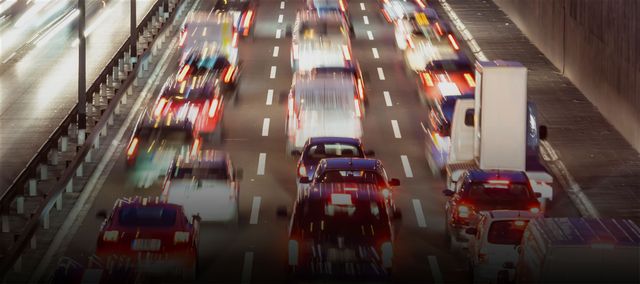24 February 2017
Again and again, heavy goods vehicles crash at high speed into the end of traffic queues because they are unable to slow down or stop in time. These accidents are serious and car drivers are afraid of them, as they are not sure what to do to stay safe. In fact, technology already exists which automatically slows down heavy vehicles, but it seems that many truck drivers switch the system off. In the following interview, Ralf Buchstaller, Head of the Medical-Psychological Institute at TÜV NORD, explains why this happens and what car drivers can do to preserve their own safety.
#explore: What is it that car drivers generally do wrong when they find themselves in a traffic queue?
Ralf Buchstaller: The most frequent mistake drivers make is that they wait too long to reduce their speed and then switch on the hazard warning lights too late. This means that the following traffic is not informed early enough that they are approaching the end of a traffic queue. The earlier car drivers warn other drivers about a queue, the more time they will have to react.
What is the correct way to behave in a queue situation?
Without fail, drivers should pay attention to warning notices that are in place at critical points on motorways, and should then anticipate a traffic hold-up or queue. The best thing to do is to immediately increase the distance to the driver in front as soon as traffic becomes more dense. And the hazard warning lights should be switched on immediately – better ten times too early than once too late.
Shouldn’t drivers also keep looking in their rear view mirror to find out if the following cars are braking in good time?
That certainly makes sense. In an emergency, it is then possible to react fast and escape onto the hard shoulder.
“The majority of accidents can be attributed to human error. The main causes are exceeding the speed limit and driving under the influence of alcohol or drugs.”
Which psychological aspects play a role in creating hazardous situations at the end of a queue?
In my opinion, complacency is the main problem – and not really fear. Many drivers do not take the warning signs seriously, that nothing is going to happen and allow themselves to be distracted. A great many dangers could be avoided if all drivers reacted to warning signs in good time.
Accidents where heavy goods vehicles crash into the end of a queue at high speed seem to be on the increase. Are people becoming more anxious about collisions like this?
It is not possible to ignore this development, but statistics still show that motorways are the safest roads of all. Despite this, dramatic pile-ups are remembered for a particularly long time because they generally cause a great deal of damage – and their significance is therefore slightly exaggerated.
Driver assist systems are now available for lorries and trucks which brake the vehicle automatically well before the end of a queue or traffic jam. This could prevent a large number of accidents. But many drivers seem to be switching these assist systems off. Why?
This technology often makes everyday work more difficult for drivers. They like to drive up close behind other trucks in order to overtake in as little time as possible. But if the vehicle distance warning technology is switched on, they cannot do this. Then they need longer to overtake, and this is unpopular with other road users.
And a final question: Which do you think presents the greater danger when driving – drivers themselves or technology?
The majority of accidents can be attributed to human error. The main causes are exceeding the speed limit and driving under the influence of alcohol or drugs. Only a very few accidents are caused by technical failures. I would go so far as to say that modern technology can reduce the number of accidents, because drivers can be automatically prevented from driving too fast.
YOU MAY ALSO LIKE
ABOUT RALF BUCHSTALLER
© TÜV NORD
Ralf Buchstaller has been working for 25 years as a psychologist in the field of driving aptitude testing. His speciality is “older drivers”. He is a member of the VdTÜV Commission entitled “Traffic Medicine and Traffic Psychology” and the “German Association for Traffic Psychology DGVP”. He has been with TÜV NORD since 2002. There he currently runs the Medical-Psychological Institute (MPI) in Hamburg.



